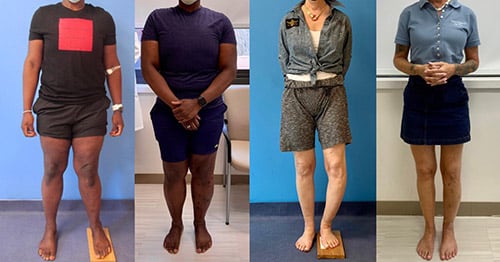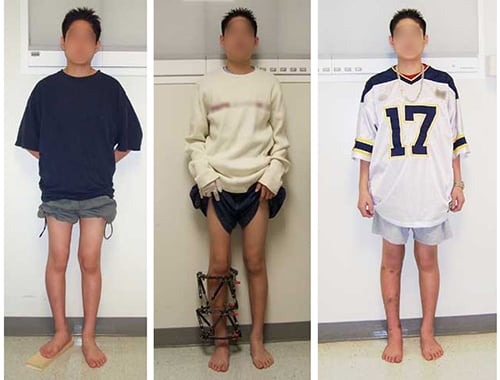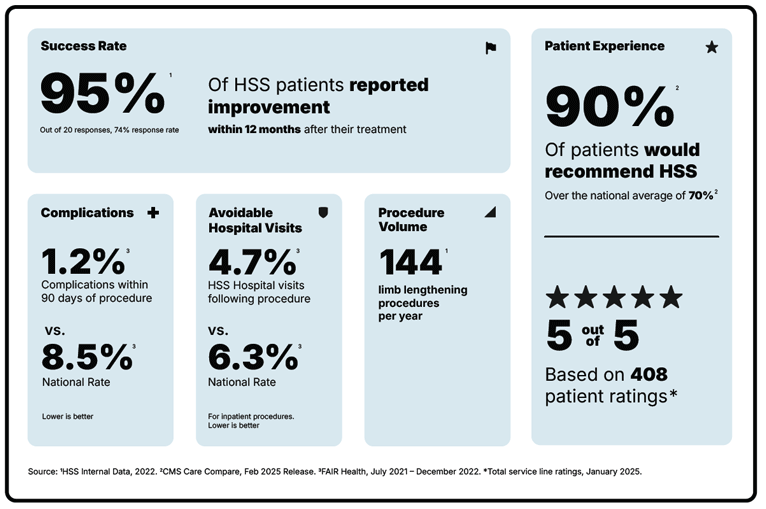Leg Length Discrepancy
Limb length differences, in which one arm or leg is shorter than the other, can be debilitating and lead to other medical problems, such as back, shoulder, hip or knee pain. Although limb length discrepancies can affect the arms and hands, leg length discrepancies are more common. Leg length discrepancy can be a problem for adults or children and can be caused by a congenital or acquired problems. Many patients with significant length differences will benefit from limb lengthening surgery.

Two HSS patients with corrected leg length discrepancies, before and after surgery.
What is a leg length discrepancy?
A leg length discrepancy (one leg shorter than the other), is also called anisomelia or short-leg syndrome. This condition can affect both children and adults.
What causes one leg to be longer than the other?
Most cases of unequal leg length are congenital conditions (those people are born with). But other, acquired cases may be caused by traumas or infections that damage bone growth plates, poorly healed bone fractures, or bone tumors, all of which can affect growth and cause one leg to be shorter than the other. For example, it is a common issue among people who have survived a polio (poliovirus) infection.
Congenital conditions that cause leg length discrepancies
- Fibular hemimelia. Also called longitudinal fibular deficiency, this is where a person is born with an underdeveloped or missing fibula bone.
- Congenital short femur, this is a severe shortening or complete absence of the femur bone.
- Hemiatrophy, in which one side of the body grows significantly smaller than normal and in relation to the other side. This may be seen in in children with Russell-Silver syndrome.
- Hemihypertrophy (also called hemihyperplasia). This is where one side of the body grows significantly larger than normal and in relation to the other side. One form of this congenital condition is called Beckwith-Wiedermann syndrome.
Acquired conditions that cause leg length discrepancies
- In children, damage to a growth plate can cause a bone to stop growing prematurely, leading to leg length discrepancy and deformity. Growth plate damage is often a result of:
- Severe traumas to a bone – such as a fracture occurring from a car accident, high fall or other extreme-force impact injuries.
- Bone infections (osteomyelitis). Many kinds of superficial infections (such as Staphylococcus aureas or “staph”) can travel through the bloodstream to form a deep infection in a joint or bone growth plate, since there is significant blood flow in these areas. Younger children whose immune systems have not fully developed are especially susceptible to bone infections.
- Benign bone tumors such as simple bone cyst or enchondromas or osteochondromas can affect the growth plate and inhibit growth resulting in limb shortening and deformity.
- Even in cases where the growth plate is not damaged, bone fractures can sometimes heal in an abnormal position (called malunion), leading to shortening and deformity.
- Bone tumor conditions that can lead to shortening and deformation of the bone include:
- Fibrous dysplasia – in which fibrous tissue incorrectly grows in place of bone tissue, weakening and/or deforming the bone. This type of noncancerous tumor often affects the femur (thighbone), tibia (shinbone) or humerus (upper arm bone).
- Neurofibromatosis.
- Ollier disease. In this condition, cysts or tumors called enchondromas, which are formed from cartilage tissue, develop in the bone marrow in close proximity to cartilage of the growth plate.
- Neurologic conditions may also affect limb length. Conditions like polio or nerve injury from a young age or birth like spina bifida may cause leg length discrepancy.
- Bone loss from tumors, trauma or infection can lead to leg length discrepancy.

Leg length discrepancy before surgery, wearing a lengthening external fixator, and after surgery.
How much leg length discrepancy is normal?
A leg length discrepancy of less than 10 mm is often well tolerated and rarely requires surgical treatment. Having a 10-mm or greater difference in leg length creates an asymmetry in the body that may cause lower back pain, hip pain and other problems.
How do you measure leg length discrepancy?
Leg length discrepancy is measured on both physical examination using the block method and with standing, full-length X-rays.
What problems can leg length discrepancy cause?
Having legs of unequal length creates an imbalance in posture and gait (the manner in which a person walks) that places stress on the low back and hip. This places stress on the lower back, hip, knee and ankle, which can lead to premature joint degeneration (osteoarthritis). In some cases, it can also lead to functional scoliosis.
How do you fix leg length discrepancy?
In appropriate patients, orthopedic limb lengthening surgery can be used to increase the length of the shorter leg to be even with that of the other.
Why you should choose HSS for femur lengthening
Limb lengthening of the femur is a surgery focused on improving your ability to walk and getting you back to the activities you love. But not all hospitals achieve the same results. Some are more reliable than others. With the help of the HSS Hospital Reliability Scorecard, you can make sure you're asking the critical questions to find the hospital that's right for you. Understanding the data points will help you make the best decision for your care. See hospital reliability data
Medically reviewed by S. Robert Rozbruch, MD
References
- Friend L, Widmann RF. Advances in management of limb length discrepancy and lower limb deformity. Curr Opin Pediatr. 2008 Feb;20(1):46-51. doi: 10.1097/MOP.0b013e3282f35eeb. PMID: 18197038.
- Goodbody CM, Buksbaum J, Harbison MD, Fragomen AT, Rozbruch SR. Limb Lengthening in Russell-Silver Syndrome: An Update Confirming Safe and Speedy Healing. J Pediatr Orthop. 2021 May 13. doi: 10.1097/BPO.0000000000001855. Epub ahead of print. PMID: 33999566.
- Heath MR, Shin TJ, Mehta R, Principe PS, Mackie AT, Fragomen A, Rozbruch SR, Fabricant PD. Patients With Lower Limb Deformity Report Worse Quality of Life Than Control Subjects Regardless of Degree of Deformity. J Am Acad Orthop Surg Glob Res Rev. 2021 Aug 10;5(8):e21.00182. doi: 10.5435/JAAOSGlobal-D-21-00182. PMID: 35103625; PMCID: PMC8357251.
- Reif TJ, Matthias J, Fragomen AT, Rozbruch SR. Limb Length Discrepancy and Angular Deformity due to Benign Bone Tumors and Tumor-like Lesions. J Am Acad Orthop Surg Glob Res Rev. 2021 Mar 10;5(3):e00214. doi: 10.5435/JAAOSGlobal-D-20-00214. PMID: 33720060; PMCID: PMC7954373.
- Ruzbarsky JJ, Goodbody C, Dodwell E. Closing the growth plate: a review of indications and surgical options. Curr Opin Pediatr. 2017 Feb;29(1):80-86. doi: 10.1097/MOP.0000000000000438. PMID: 27845969.
- Sheha ED, Steinhaus ME, Kim HJ, Cunningham ME, Fragomen AT, Rozbruch SR. Leg-Length Discrepancy, Functional Scoliosis, and Low Back Pain. JBJS Rev. 2018 Aug;6(8):e6. doi: 10.2106/JBJS.RVW.17.00148. PMID: 30130357.

